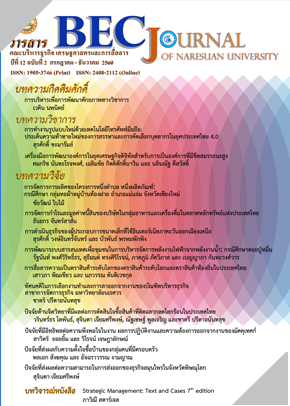Factors Affecting Export Ability of Herbal Business in Phitsanulok Province
Main Article Content
Abstract
Nowadays, the export demands of herbs are increasing, resulting the increase income from exports, with more than 100 billion baht’s in 2016 especially supplementary food, spa and traditional Thai medicine. However, imports is trend to higher in value than its exports. Therefore, it is necessary to increasing the country’s export potential in order to generate more income to sharpen the competitive edge, and to increase the potential for herb exports as great importance. Most of the herb businesses in are small and medium sized enterprises and facing multiple problems such as not meeting the international standards for qualified products, not meeting the market’s demands for production quantity, having high production costs, and having production techniques, management and marketing, etc. This study investigates the factors affecting the success of the herb businesses in Phitsanulok Province, and explores suitable business formats for exporting herbs and competing in the business. The research questions are as follows: 1) What are the marketing potential and opportunities for exporting herb products in Phitsanulok Province? 2) What are the factors influencing the success of exporting herb products in Phitsanulok Province?. The findings reveal that internal factors, namely the conditions of the production factors, organizational structure, and demand conditions, are at a high level. As for external factors, only the political environment and the social environment are at a high level. The export potential of Phitsanulok Province is at a high level. The success factors of the export of herb products are the high ability to compete, the product merits, competitive prices, the ability for continual market expansion, and the ability concerning distribution channels to reach the target customers and to distribute their products faster than the competitors.
Article Details
References
2. Analoui, F. (2007). Strategic Human resource management. London: Thomson Learning.
3. Barney, J. (1991). Firm resources and sustained comparative advantage. Journal of management, 17(1), 99-120.
4. Cavusgil, S. T. and Naor, J. (1987). Firm and management characteristics as discriminators of export marketing activity. Journal of Business Research, 15(3), 221-235.
5. Cavusgil, T. and Zou, S. (1994). Marketing Strategy-performance relationship: An investigation. Journal of Marketing, 58(1), 1-21.
6. Chetty, S. K. and Hamilton, R. T. (1993). Firm-level determinants of export performance: A meta-analysis. International Marketing Review, 10(3), 26-34.
7. Chemsripong, S. (2012). Capacity building program linking quality agricultural and agricultural marketing. Phitsanulok: Phitsanulok City Hall.
8. Chemsripong, S. (2014). The project supports the standardization of goods and services of the provinces to build competitiveness and create value added products. Phitsanulok: Naresuan University.
9. Christensen, C. H., da Rocha, A. and Gertner, R. K. (1987). An empirical investigation of the factors influencing exporting success of Brazilian firms. Journal of international Business studies, 18(3), 61-77.
10. Culpan, R. (1989). Export behavior of firms: Rlvance of firm size. Journal of Business Research, 18(3), 207-218.
11. Department of Thai Traditional and Alternative Medicine. (2013). Thailand champion herbal products. Bangkok: Ministry of public health.
12. Department of International Trade Promotion Ministry of Commerce. (2013). Thai herbs for export. Bangkok: Ministry of Commerce.
13. Dijik, M. V. (2002). The determinants of export performance in developing countries: The case of Indonesian Manufacturing. Eindhoven: Eindhoven Centre for Innovation Studies.
14. Julian, C. C. (2003). Export marketing performance: A study of Thailand Firms. Journal of Small Business Management, 41(2), 213-221.
15. Kaynak, E. and Kuan, W. Y. (1993). Environment, strategy, structure, and performance in the context of export activities: An empirical study of Taiwaneses manufacturing firms. Journal of Business Research, 27(1), 33-49.
16. Katsikea, E. S. and Skarmeas, D. A. (2003). Organisational and managerial drivers of effective export sales organizations. European Journal of Marketing, 37(11/12), 1723-1745.
17. Leonidou, L. C., Katsikeas, C. S. and Samieec, S. (2002). Marketing strategy determinants of export performance: A mete-analysis. Journal of Business research, 55(1), 51-67.
18. Madsen, T. K. (1989). Successful Export Marketing Management: Some empirical evidence. International Marketing Review, 6(4), 41-57.
19. Mooney, A. (2007). Core competence, distinctive competence and competitive advantage: What is the difference?. Journal of Education for Business. 82(2), 110-115.
20. National Innovation Agency. (2016). Thai herbal products report. Bangkok: National Innovation Agency publisher.
21. Porter, M. E. (1985). Competitive advantage: Creating and sustaining superior performance. New York: The Free Press.
22. Porter, M. E. (1990). The Comparative Advantage of Nations. New York: Free Press.
23. Porter, M. E. (1998). The Adam smith address: Location, clusters, and the new microeconomics of competition. Business Economics, 3(1), 1-7.
24. Porter, M. E. (1998). The Competitive Advantage of Nations. New York: MacMillan.
25. Porter, M. E. and Ketels, C. H. M. (2003). UK Competitiveness: Moving to the next stage. UK: DTI Economics paper.
26. Shoham, A. (1996). Marketing-mix standardization: Determinants of export performance. Journal of Global Marketing, 10(2), 53-73.
27. Shoham, A. (1998). Export Performance: A Conceptualization and Empirical Assessment. Haifa: University of Haifa.
Sousa, C. M. P. (2004). Export performance measurement: An evaluation of empirical research in the literature. Academy of Marketing Science Review. 9(1), 1-22.
28. Tesfom, G. and Lutz, E. (2006). A classification of export marketing problems of small medium sized manufacturing firms in developing countries. International journal of Emerging Markets, 1(3), 262-284.
29. Zou, S. and Stan, S. (1998). The determinants of export performance: A review of the empirical literature between 1987and 1997. International Marketing Review, 15(5), 333-356.

